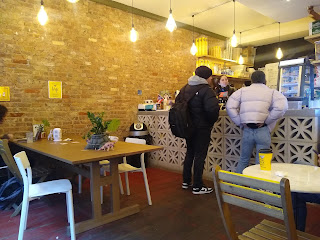 |
| Michigan Street (US 20), main street of New Carlisle |
My recent conference experience in Chicago included a side trip to New Carlisle, Indiana, where a longtime friend has returned to the place she grew up. I don't know what I expected, but I found a pleasant burg with many of the admirable qualities of traditional small towns.
"I live in a 15-minute city," my friend said, and she does. She lives a block from the center of town, which contains restaurants and coffee and ice cream, but also--and this is a key quality of walkable areas--groceries and hardware as well as a Walgreen's. Ben Kaplan wants vegetables with his urbanism--New Carlisle has vegetables, within a short though not particularly friendly walk from anywhere in town.
 |
| Groceries By Joe is at the edge of town, where there are no sidewalks, but they do have vegetables (Google Earth screenshot) |
New Carlisle's population in 2020 was 1891, up exactly thirty over 2010: 91 percent are white, 2 percent black, and the rest other or multiple races. 39 percent are between ages 25 and 54, 14 percent are over age 65, on the young side of average for the State of Indiana. Median income and educational attainment are lower than Indiana as a whole, but so is poverty (data.census.gov). The town is bisected by U.S. 20 a.k.a. Michigan Street, but it is only two lanes wide through town, which at least by my brief observations seemed to slow the traffic whether local or passing through. So people on either side of the highway can walk to a terrific park:
.png) |
| Memorial Park, 300 W Michigan St (Google Earth screenshot) |
.png) |
| Olive School, 300 W Ben St (Google Earth screenshot) |
...and the library is across the street from the school.
.png) |
| Olive Township Library, 408 Bray St (Google Earth screenshot) |
The most distant house I could find that qualified as in town was only 15 minutes' walk away from the library, according to Google, with sidewalks all the way.
A glossy brochure I scored in town offers a self-guided tour of New Carlisle's history and architecture, with 31 properties listed (23 residential, eight commercial) along with some good basic information on architectural styles. Anyone interested in functional historic preservation would not be out of place here.
 |
| building facades, 100 block of East Michigan Street, showing Queen Anne (1892) and Italianate (1874) styles |
New Carlisle is about halfway between Michigan City (pop. 32,075) and South Bend (pop. 103,453). Transportation out of town is probably going to be by car. Chicago is 2+ hours away by train, though; the South Shore Line train to Chicago stops at Hudson Lake, a 5-minute drive, and there's talk of moving the station to New Carlisle.
Would I like it here? I can't say for sure, as I've never lived in a town under 10,000 population, and I've spent my entire adult life in towns with at least one college. There is coffee to be had on Michigan Street, at both Carlisle Coffee and New Age Baking Company. And the accessibility of most things can't be beat.
 |
| Carlisle Coffee and Sweets, 203 E Michigan St (Google Earth screenshot) |























